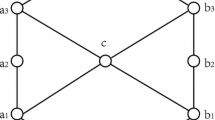Abstract
The original model of rough sets was advanced by Pawlak, which was mainly involved with the approximation of things using an equivalence relation on the universal set of his approximation space. In this paper, two kinds of approximation operators via ideals which represent extensions of Pawlak’s approximation operator have been presented. In both kinds, the definitions of upper and lower approximations based on ideals have been given. Moreover, a new type of approximation spaces via two ideals which is called bi-ideal approximation spaces was introduced for the first time. This type of approximations was analyzed by two different methods, their properties are investigated, and the relationship between these methods is proposed. The importance of these methods was its dependent on ideals which were topological tools, and the two ideals represent two opinions instead of one opinion. At the end of the paper, an applied example had been introduced in the chemistry field by applying the current methods to illustrate the definitions in a friendly way.
Similar content being viewed by others
References
Allam AA, Bakeir MY, Abo-Tabl EA (2005) New approach for basic rough set concepts. In: International workshop on rough sets, fuzzy sets, data mining, and granular computing. Lecture notes in artificial intelligence 3641, Springer, Regina, pp 64–73
Allam AA, Bakeir MY, Abo-Tabl EA (2006) New approach for closure spaces by relations. Acta Mathematica Academiae Paedagogicae Nyregyhziensis 22:285–304
Allam AA, Bakeir MY, Abo-tabl EA (2008) Some methods for generating topologies by relations. Bull Malays Math Sci Soc 31:35–45
Chakrabarty K, Biswas R, Nanda S (2000) Fuzziness in rough sets. Fuzzy Sets Syst 110:247–251
El-Sheikh SA, Hosny M, Raafat M (2017) Comment on “Rough multisets and information multisystems”. Adv Decis Sci Article ID 3436073
El-Tayar NE, Tsai RS, Carruptand PA, Testa B (1992) Octan-1-ol-water partition coefficients of zwitterionic \(\alpha \)-amino acids. J Chem Soc Perkin Trans 2:79–84
Frege G (1893) Grundlagen der Arithmetik, vol 2. Verlag von Herman Pohle, Jena
Girish KP, John SJ (2011) Rough multisets and information multisystems. Adv Decis Sci Article ID 495392, 1–17
Girish KP, John SJ (2014) On rough multiset relations. Int J Granular Comput Rough Sets Intell Syst 3:306–326
Hosny M (2011) Rough sets and its applications in the network, Master’s Thesis. Ain Shams University, Cairo, Egypt
Hosny M, Raafat M (2017a) On generalization of rough multiset via multiset ideals. Intell Fuzzy Syst 33:1249–1261
Hosny M, Raafat M (2017b) A note on “On generalizing covering approximation space”. J Egypt Math Soc. https://doi.org/10.1016/j.joems.2017.05.005
Jian L, Liu S, Lin Y (2011) Hybrid rough sets and applications in uncertain decision-making. Auerbach Publications, Boca Raton
Kandil A, Yakout MM, Zakaria A (2013) Generalized rough sets via ideals. Ann Fuzzy Math Inform 5:525–532
Kozae AM, El-Sheikh SA, Hosny M (2010) On generalized rough sets and closure spaces. Int J Appl Math 23:997–1023
Kryszkiewicz M (1998) Rough set approach to incomplete information systems. Inform Sci 112:39–49
Lin TY, Liu Q (1994) Rough approximate operators: axiomatic rough set theory. In: Ziarko W (ed) Rough sets, fuzzy sets and knowledge discovery. Springer, Berlin, pp 256–260
Ma X, Liu Q, Zhan J (2017) A survey of decision making methods based on certain hybrid soft set models. Artif Intell Rev 47:507–530
Pal S, Mitra P (2004) Case generation using rough sets with fuzzy representation. IEEE Trans Knowl Data Eng 16:293–300
Pawlak Z (1982) Rough sets. Int J Inf Comput Sci 11:341–356
Skowron A, Stepaniuk J (1996) Tolerance approximation spaces. Fundamenta Informaticae 27:245–253
Slowinski R, Vanderpooten D (2000) A generalized definition of rough approximations based on similarity. IEEE Trans Knowl Data Eng 12:331–336
Walczak B, Massart DL (1999) Tutorial rough sets theory. Chemometr Intell Lab Syst 47:1–16
Yao YY (1996) Two views of the theory of rough sets in finite universes. Int J Approx Reason 15:291–317
Yao YY (1998a) Constructive and algebraic methods of theory of rough sets. Inf Sci 109:21–47
Yao YY (1998b) Relational interpretations of neighborhood operators and rough set approximation operators. Inf Sci 111:239–259
Yao YY, Lin TY (1996) Generalization of rough sets using modal logic. Intell Autom Soft Comput 2:103–120
Yao YY (2003) On generalizing rough set theory. In: Proceedings of the 9th international conference rough sets, fuzzy sets, data mining, and granular computing, LNAI 2639, pp 44–51
Zhu W, Wang F (2003) Reduction and axiomization of covering generalied rough sets. Inf Sci 152:217–230
Ziarko W (1993) Variable precision rough set model. J Comput Syst Sci 46:39–59
Acknowledgements
The third author extends her appreciation to the Deanship of Scientific Research at King Khalid University for funding this work through research groups program under Grant (R.G.P.1/148/40).
Author information
Authors and Affiliations
Corresponding author
Ethics declarations
Conflict of interest
The authors declare that they have no conflict of interest.
Ethical approval
This article does not contain any studies with human participants or animals performed by any of the authors.
Additional information
Communicated by V. Loia.
Publisher's Note
Springer Nature remains neutral with regard to jurisdictional claims in published maps and institutional affiliations.
Rights and permissions
About this article
Cite this article
Kandil, A., El-Sheikh, S.A., Hosny, M. et al. Bi-ideal approximation spaces and their applications. Soft Comput 24, 12989–13001 (2020). https://doi.org/10.1007/s00500-020-04720-2
Published:
Issue Date:
DOI: https://doi.org/10.1007/s00500-020-04720-2




